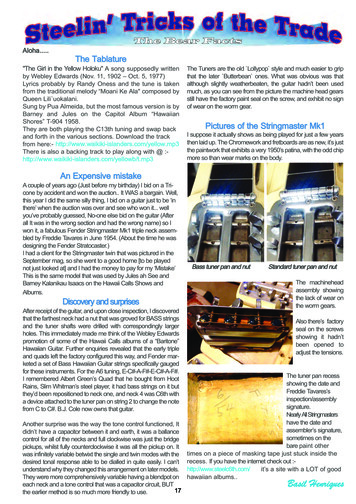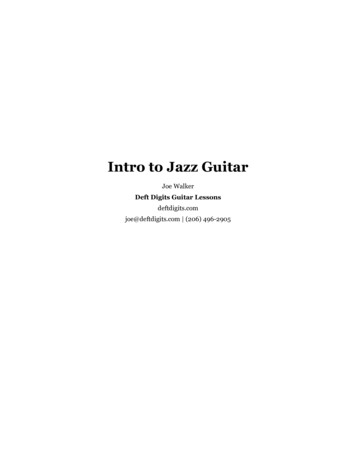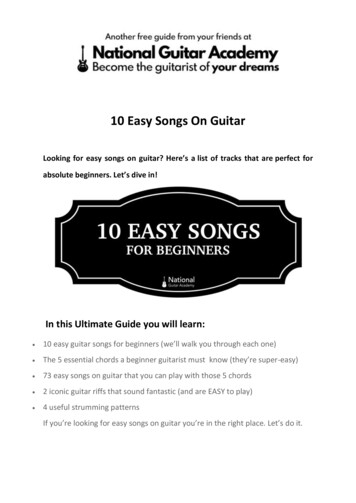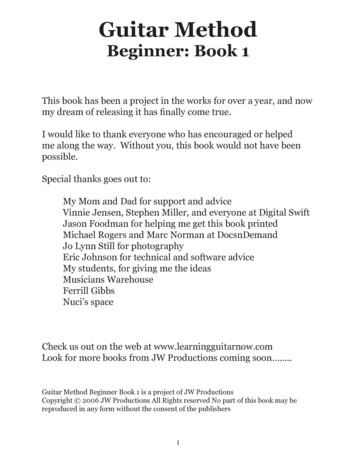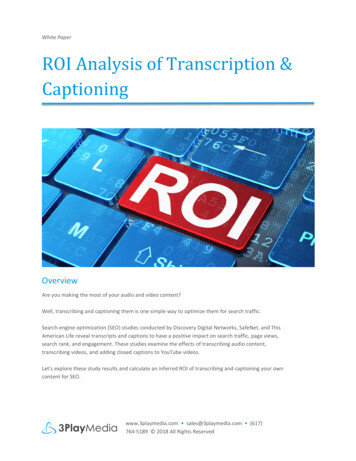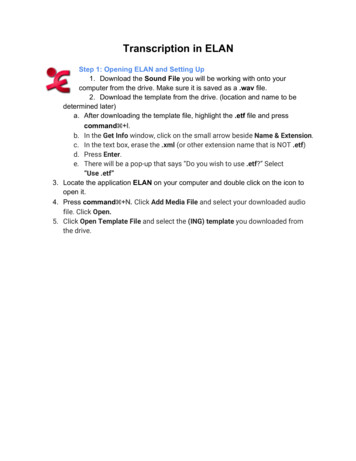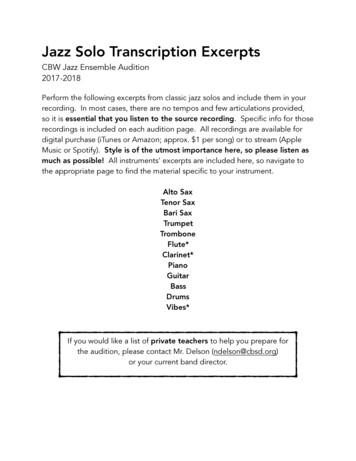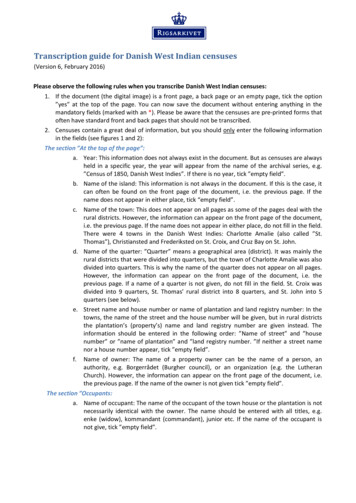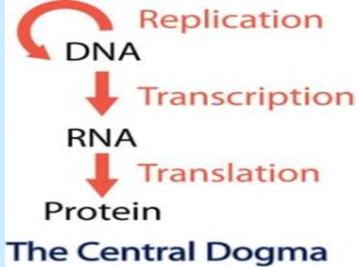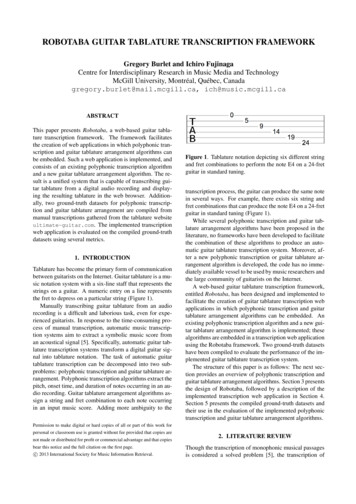
Transcription
ROBOTABA GUITAR TABLATURE TRANSCRIPTION FRAMEWORKGregory Burlet and Ichiro FujinagaCentre for Interdisciplinary Research in Music Media and TechnologyMcGill University, Montréal, Québec, Canadagregory.burlet@mail.mcgill.ca, ich@music.mcgill.caABSTRACTThis paper presents Robotaba, a web-based guitar tablature transcription framework. The framework facilitatesthe creation of web applications in which polyphonic transcription and guitar tablature arrangement algorithms canbe embedded. Such a web application is implemented, andconsists of an existing polyphonic transcription algorithmand a new guitar tablature arrangement algorithm. The result is a unified system that is capable of transcribing guitar tablature from a digital audio recording and displaying the resulting tablature in the web browser. Additionally, two ground-truth datasets for polyphonic transcription and guitar tablature arrangement are compiled frommanual transcriptions gathered from the tablature websiteultimate-guitar.com. The implemented transcriptionweb application is evaluated on the compiled ground-truthdatasets using several metrics.1. INTRODUCTIONTablature has become the primary form of communicationbetween guitarists on the Internet. Guitar tablature is a music notation system with a six-line staff that represents thestrings on a guitar. A numeric entry on a line representsthe fret to depress on a particular string (Figure 1).Manually transcribing guitar tablature from an audiorecording is a difficult and laborious task, even for experienced guitarists. In response to the time-consuming process of manual transcription, automatic music transcription systems aim to extract a symbolic music score froman acoustical signal [5]. Specifically, automatic guitar tablature transcription systems transform a digital guitar signal into tablature notation. The task of automatic guitartablature transcription can be decomposed into two subproblems: polyphonic transcription and guitar tablature arrangement. Polyphonic transcription algorithms extract thepitch, onset time, and duration of notes occurring in an audio recording. Guitar tablature arrangement algorithms assign a string and fret combination to each note occurringin an input music score. Adding more ambiguity to theFigure 1. Tablature notation depicting six different stringand fret combinations to perform the note E4 on a 24-fretguitar in standard tuning.transcription process, the guitar can produce the same notein several ways. For example, there exists six string andfret combinations that can produce the note E4 on a 24-fretguitar in standard tuning (Figure 1).While several polyphonic transcription and guitar tablature arrangement algorithms have been proposed in theliterature, no frameworks have been developed to facilitatethe combination of these algorithms to produce an automatic guitar tablature transcription system. Moreover, after a new polyphonic transcription or guitar tablature arrangement algorithm is developed, the code has no immediately available vessel to be used by music researchers andthe large community of guitarists on the Internet.A web-based guitar tablature transcription framework,entitled Robotaba, has been designed and implemented tofacilitate the creation of guitar tablature transcription webapplications in which polyphonic transcription and guitartablature arrangement algorithms can be embedded. Anexisting polyphonic transcription algorithm and a new guitar tablature arrangement algorithm is implemented; thesealgorithms are embedded in a transcription web applicationusing the Robotaba framework. Two ground-truth datasetshave been compiled to evaluate the performance of the implemented guitar tablature transcription system.The structure of this paper is as follows: The next section provides an overview of polyphonic transcription andguitar tablature arrangement algorithms. Section 3 presentsthe design of Robotaba, followed by a description of theimplemented transcription web application in Section 4.Section 5 presents the compiled ground-truth datasets andtheir use in the evaluation of the implemented polyphonictranscription and guitar tablature arrangement algorithms.Permission to make digital or hard copies of all or part of this work forpersonal or classroom use is granted without fee provided that copies arenot made or distributed for profit or commercial advantage and that copiesbear this notice and the full citation on the first page.c 2013 International Society for Music Information Retrieval.2. LITERATURE REVIEWThough the transcription of monophonic musical passagesis considered a solved problem [5], the transcription of
polyphonic music is still an open problem [1]. Severaltechniques have been proposed to accomplish the task ofpolyphonic transcription, including human audition modelling [12]; salience methods, which apply transformationsto the input audio signal in order to emphasize the underlying fundamental frequencies [17]; iterative and joint fundamental frequency estimation algorithms followed by notetracking algorithms [2]; and a variety of machine learningmethods such as non-negative matrix factorization [14],support vector machines [8], neural networks [6], and hidden Markov models [10].Several algorithms have also been proposed to generatetablature from a symbolic music score according to criteria that minimizes the performance difficulty of the tablature arrangement. Heijink and Meulenbroek [4] established that guitarists have a disposition toward instrumentfingering positions that are biomechanically easy to perform. Specifically, guitarists favour hand positions nearthe head of the guitar and avoid composing arrangementsthat require extensive hand repositioning and large fingerspans. Shortest-path graph search algorithms [13], constraint satisfaction algorithms [9], neural networks [15],and genetic algorithms [16] have been used to search fortablature arrangements with minimal performance difficulty.3. FRAMEWORK DESIGNThe Robotaba transcription framework is composed of threemodules: a polyphonic transcription module, a guitar tablature arrangement module, and a guitar tablature engraving module (Figure 2).Three benefits arise from this modular design: First,each module can be used independently or together. Usedindependently, an input file is sent directly to a module forprocessing, which returns a result instead of passing theoutput to the next module in the workflow. Using eachmodule in sequence, guitar tablature can be generated froman input audio file and displayed in the web browser. Second, the modular design facilitates algorithm interchangeability. Assuming an algorithm produces valid output, itcan be inserted into a module without disturbing the functionality of surrounding modules. As a result, the transcription framework can accommodate new state-of-the-artpolyphonic transcription or guitar tablature arrangementalgorithms without substantial changes to the web application. Third, the use of a single symbolic music file format for data interchange between modules promotes polyphonic transcription and tablature arrangement algorithmsto adhere to a common interface. Robotaba uses the 2012release of the music encoding initiative (MEI): an extensible markup language (XML) file format that encodes symbolic music notation in a hierarchical fashion [11].3.1 Polyphonic Transcription ModuleThe polyphonic transcription module accepts an audio fileas input, which is passed to the polyphonic transcriptionalgorithm embedded in the module. The polyphonic transcription algorithm is responsible for generating an MEIFigure 2. Modular architecture of the Robotaba guitar tablature transcription framework.file containing the estimates of note events occurring in theinput audio file. The polyphonic transcription module optionally postprocesses the output symbolic music file bylimiting the number of simultaneous notes to six, and discarding or transposing estimated notes that are outside ofthe range of a specific guitar. Properties of the guitar (number of frets, tuning, and capo position) 1 and postprocessing options are specified by the user of the web application.3.2 Guitar Tablature Arrangement ModuleThe guitar tablature arrangement module accepts an MEIfile as input, which is mandatorily preprocessed in an identical manner as the postprocessing step of the polyphonictranscription module described in the previous section. Thepreprocessed MEI file is subsequently passed to the guitartablature arrangement algorithm embedded in the module,which is responsible for assigning a guitar string and fretcombination to each note occurring in the MEI file.3.3 Guitar Tablature Engraving ModuleThe guitar tablature engraving module is responsible forparsing an MEI file containing a sequence of note eventsthat have each been assigned a guitar string and fret combination and displaying the encoded tablature in the webbrowser. Robotaba uses the digital guitar tablature engraving library AlphaTab 2 to render tablature symbols on thehypertext markup language (HTML) canvas element. AlphaTab parses drawing scripts called AlphaTex, in whichstructured keywords inform the rendering engine about thecontents of the tablature and how it should be displayed.When an MEI file is passed to the tablature engraving module, the contents of the file are converted to an AlphaTexdrawing script to be rendered by AlphaTab. A renderedtablature score can be seen in Figure 1.3.4 Framework ImplementationRobotaba is implemented using Django, 3 a Python webframework that facilitates rapid development of databasedriven web applications by automatically translating Pythonclasses called models into relational database tables. Models are created for audio and symbolic music files, as wellas their associated metadata. Additionally, the database1 A capo is a device that is clipped onto the fretboard of a guitar andraises the pitches of the open strings.2 www.alphatab.net3 www.djangoproject.com
stores the user-specified parameters used to generate a transcription, such as the guitar properties and file pre and postprocessing options, to allow reproducibility of results.4. TRANSCRIPTION WEB APPLICATIONUsing the Robotaba framework, a web application for guitar tablature transcription is developed that incorporatesthe polyphonic transcription and guitar tablature arrangement algorithms described in this section. 44.1 Polyphonic Transcription AlgorithmA polyphonic transcription application, which uses the stateof-the-art algorithm proposed by Zhou and Reiss [17], isimplemented. This algorithm was selected for several reasons: First, this algorithm ranked highest out of the polyphonic transcription algorithms evaluated in the Music Information Retrieval Evaluation eXchange (MIREX) on thepiano dataset from 2007–2012 when considering the accuracy of pitch and note onset times only. Second, theauthors tuned underlying parameters of the algorithm according to a dataset composed of both piano and guitarrecordings [17]. Third, this algorithm is capable of performing polyphonic transcriptions in realtime. Finally, thesource code of this algorithm is open source.The aforementioned polyphonic transcription algorithmis distributed as a Vamp plugin written in the C programming language. A Vamp plugin is an audio featureextraction module that must be “plugged into” a host application. 5 In order to integrate the polyphonic transcription Vamp plugin into Robotaba, the plugin is first divorcedfrom the host to produce a standalone application. A Pythoninterface is created using the Boost.Python library 6 to access the standalone application from Robotaba. A Pythonapplication is implemented, which sets parameters of thepolyphonic transcription algorithm, imports an audio file,sends the audio data to the Python bindings of the polyphonic transcription Vamp plugin, and generates an MEIdocument containing the resulting note event estimates.4.2 Guitar Tablature Arrangement AlgorithmA new guitar tablature arrangement algorithm entitled Astar-guitar is developed, written in the Python programming language, and embedded in the Robotaba guitar tablature arrangement module. Extending the approach proposed by Sayegh [13], which uses the Viterbi algorithmto search for an optimal path through a weighted graph ofcandidate fretboard locations for notes in a monophonicmusical passage, A-star-guitar uses the popular A* pathfinding algorithm [3] to search for an optimal tablature arrangement of a sequence of notes and chords in a polyphonic musical passage.The A* pathfinding algorithm searches for an optimalpath through a directed graph, in which vertices representcandidate string and fret combinations for a note or ns.org6 www.boost.org/libs/python/docin a symbolic music score. Candidate string and fret combinations are calculated by considering the number of fretson the user’s guitar, the tuning, and optional fret positionof a capo. Vertices that correspond to adjacent notes orchords in the music score are connected by an edge.The weight of an edge wij N between vertices i andj represents the biomechanical difficulty associated withthe transition between the two hand positions on the fretboard. Following the study of left-hand movements of professional guitar players by Heijink and Meulenbroek [4],the edge weight between two vertices is the cumulation ofthree biomechanical complexity factors: the fretwise distance that the fretting hand must move to accommodatenote transitions, the fretwise finger span required to perform chords, and a penalty of one if the fretting hand surpasses the seventh fret. The values of this penalty and fretthreshold number were chosen on the basis of preliminarytests and encourage tablature arrangements near the beginning of the fretboard. In the event of a note played by depressing fret number f , followed by a chord comprised ofmultiple notes with the set of fret number
the head of the guitar and avoid composing arrangements that require extensive hand repositioning and large finger spans. Shortest-path graph search algorithms [13], con-straint satisfaction algorithms [9], neural networks [15], and genetic algorithms [16] have been used to search for tablature arrangements with minimal performance difficulty .
